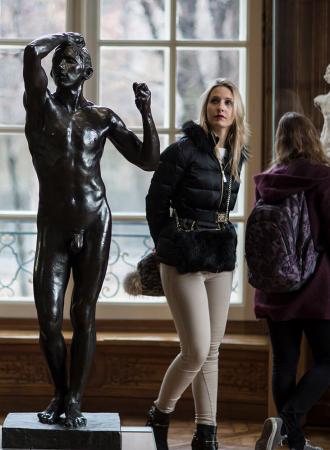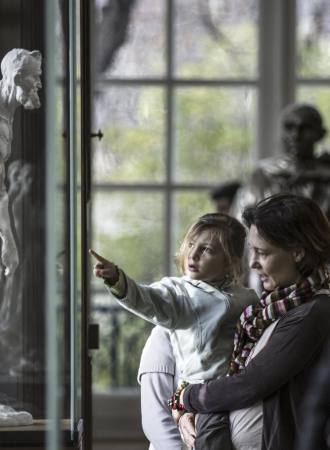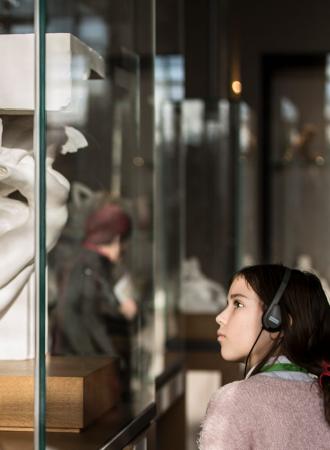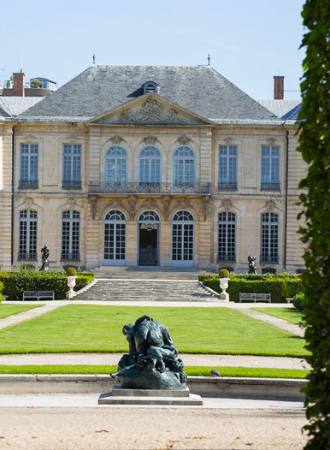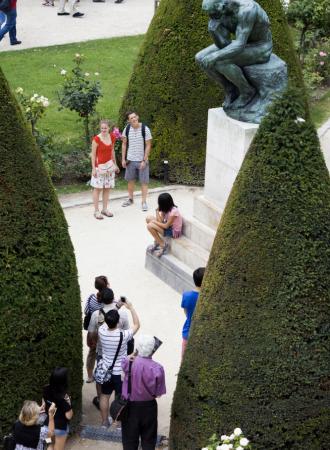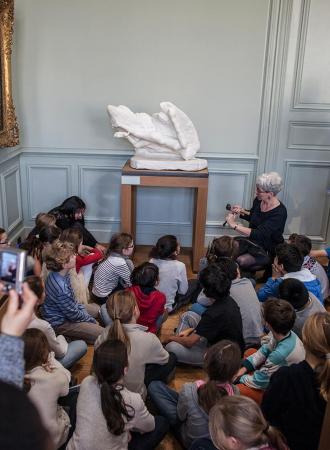Search the site
The human body in Rodin's sculpture : Nature and ideal, movement and expression
In May 1903, at the Burlington Fine Arts Club, London, Rodin saw a marble Head of a Young Woman, from Chios, belonging to Edward Perry Warren, a collector who had commissioned a marble version of The Kiss three years earlier.
Frederick Hollyer, La tête Warren, vers 1904 [Ph.2712]
The sculptor initially sought to exchange several of his own works for this Greek sculpture, then tried to purchase it at any price, but all his efforts were in vain. Rodin eventually “compensated” for his frustration the following year by writing and publishing an article on the work in the periodical Le Musée, Revue d’Art Antique. From the moment he first laid eyes on this Warren Head, Rodin could not contain his admiration, which he proclaimed in an interview given to a journalist from the Morning Post : “It’s life itself. It embodies all that is beautiful, life itself, beauty itself. It is admirable. Those parted lips. I am not a man of letters; hence I am unable to describe this truly great work of art. I feel but I cannot find the words that will give expression to what I feel. This is a Venus! You cannot imagine how much this Venus interests me. She is like a flower, a perfect jewel. So perfect that it is as disconcerting as nature itself. Nothing could describe it.” (“Interview with M. Rodin: A Praxiteles Venus”, Morning Post, 28 May 1903)
This anecdote and the exuberant praise expressed by the sculptor, who was then at the height of his artistry, reveal the primordial role awarded to the human body in his oeuvre, far beyond simple questions of anatomical accuracy. Throughout his career, the body as a vehicle for expression of the impulses of the soul, of passion, effectively constituted an inexhaustible source of inspiration in his search for the perfect means of combining ideal antique beauty with the mystery of nature.
RODIN, THE ANTIQUE IDEAL AND MICHELANGELO
“Come and see me tomorrow morning at Meudon. We will talk of Phidias and Michelangelo, and I will model statuettes for you on the principles of both. In that way you will quickly grasp the essential differences of the two inspirations, or, to express it better, the opposed characteristics which divide them.”
This invitation made by Rodin to Paul Gsell c.1910, and the modelling session and explanations that followed (in Rodin on Art and Artists: Conversations with Paul Gsell, “Phidias and Michelangelo”) reveal how aware the sculptor was of the contradictory influences exerted on his own art by Phidias’ classical example and Michelangelo’s more tormented.
Auguste Rodin, Feuilles de croquis, vers 1871-1877 [D.134-138]
In his early years of training, Rodin began studying Greek antiques and master sculptors in the Louvre, where he spent hours drawing. The numerous sketches and studies that he made in the early 1870s bear witness to his ongoing interest in the diverse models offered by different periods in art history. On the same sheet of paper, Rodin glued drawings of column statues of queens in Chartres Cathedral next to figures from the Parthenon frieze, showing how receptive he was to the expressive force peculiar to each of these aesthetic canons. This would later be borne out by the scope and heterogeneity of his collection of sculptures, in which the arts of Ancient Egypt, Greece and Rome, the Middle East, the Far East and the Middle Ages were all represented.
Auguste Rodin, L’Homme au nez cassé [S.974]
This expression of the antique ideal emerged in 1863, in Man with the Broken Nose (1863-75), among the first of Rodin’s works to move away from the more decorative style prevalent in Carrier-Belleuse’s studio. Using an old workman from the Saint-Marcel district of Paris as the sitter for his portrait bust, Rodin abandoned the search for individual resemblance so as to be closer to antique sculptures. He thus emphasized the facial features of his sitter (broken nose, wrinkles, beard) and transformed him into a Greek philosopher.
Between 1876 and 1915, Rodin made several visits to Italy, initially to discover the works of his masters, Donatello and Michelangelo, then to nurture and revive his relationship with them. He admired the emotional quality of Michelangelo’s figures, their twisting poses, the expressive force of non finito. On his very first journey, he filled sketchbook after sketchbook with studies.
Auguste Rodin, Piédestal des Titans [S.6739]
In the early 1870s, the Florentine artist’s influence on Rodin was particularly evident in his manner of sculpting the bodies of monumental figures when working for Carrier-Belleuse in Brussels: witness the Caryatids and Atlantes on the facade of a residential building in Boulevard Anspach, and the groups he carved for the Chamber of Commerce. The four figures with powerful musculature and twisting poses, modelled in the Pedestal of the Titans in the 1870s, epitomized the fruits of his research.
Further evidence of Rodin’s debt to Michelangelo can be seen in the resemblance between the model’s pose in The Age of Bronze (1877) and that of the Dying Slave (1513), as well as in the similarity of the modelling of the man’s back to Michelangelo’s handling of a Male Nude in a pen and ink drawing (1505), now in the Casa Buonarroti, Florence.
Auguste Rodin, Eve, [S.1029] | Auguste Rodin, Adam [S.1303]
This influence was again apparent in 1881, when Rodin, engrossed in the design and execution of The Gates of Hell, seems to have borrowed the pose for his Eve from her eponymn in Michelangelo’s scene of The Expulsion from Paradise, painted on the ceiling of the Sistine Chapel (1508-12). He also drew his inspiration for her pendant, Adam (1880-81), directly from the section of the fresco entitled The Creation of Adam
CAPTURING BODY AND SOUL IN MOTION
From The Age of Bronze onwards, Rodin preferred to depict a body in motion rather than to work from a fixed, academic pose. Auguste Neyt, a young Belgian soldier whom he used as a model, remembered coming into his studio, where “I had to train myself to strike the pose. It was hardly an easy thing to do. Rodin did not want straining muscles; in fact, he loathed the academic ‘pose’… The master wanted ‘natural’ action taken from real life.” (cited by Butler)
Towards the end of his life, the sculptor, in turn, described his working method to Paul Gsell: “As for me, seeker after truth and student of life as I am… I take from life the movements I observe, but it is not I who impose them. Even when a subject which I’m working on compels me to ask a model for a certain fixed pose, I indicate it to him, but I carefully avoid touching him to place him in the position, for I will reproduce only what reality spontaneously offers me. I obey Nature in everything, and I never pretend to command her. My only ambition is to be servilely faithful to her.” (Gsell, p. 11).
Auguste Rodin, L’Homme qui marche, 1907 [S.998]
This search for the veracity of nature and movement led him away from the accepted norms of bodily representation. Breaking with tradition, he chose to portray a fragmentary figure in The Walking Man (1907) – a male torso, with neither head nor arms, planted on two legs opened like a compass. Having eliminated all anecdotal details to focus on the sensation of movement, Rodin produced an unprecedented and powerfully expressive interpretation of it, reiterating the force that had so captivated him when standing before incomplete antique statues and Michelangelo’s unfinished works.
In the early 1910s, while conversing with Rodin, Paul Gsell argued that what proved that he changed nature was “that the cast would not give at all the same impression as your work”. Rodin reflected an instant and said: “That is so! Because the cast is less true than my sculpture! It would be impossible for any model to keep an animated pose during all the time that it would take to make a cast from it. But I keep in my mind the ensemble of the pose and I insist that the model shall conform to my memory of it… The cast only reproduces the exterior; I reproduce, besides that, the spirit which is certainly also part of nature. I see all the truth, and not only that of the outside.” (Gsell, p. 11)
This desire to capture the impulses of the soul through bodily movement may explain Rodin’s love of dance, which was one of his major sources of inspiration. He would rather sketch dancers than models in traditional sittings. Unlike an artist such as Degas, Rodin was not interested in classical ballet but preferred experimental dance as performed by Loie Fuller, Isadora Duncan, Nijinsky and the Ballets Russes, who liberated dance from artifice and convention and attained new heights of freedom.
Auguste Rodin, Cinq études de danseuses cambodgiennes, 1906
Rodin’s enthusiasm had ample opportunity to manifest itself: in 1889, at one of the events programmed for the Universal Exposition, he made drawings at a performance given by a Javanese dance company. In 1906, the King of Siam visited Paris, accompanied by a troupe of Cambodian dancers, whom Rodin followed to Marseilles. He executed about fifty life drawings of them in watercolours, notably studies of hand movements.
Auguste Rodin, Hanako, 1907
The following year, Loie Fuller arranged for Rodin to attend a show performed by the Japanese dancer Hanako, whom he then regularly asked to pose, over the next few years until 1911, for numerous drawings and a series of masks. During the same period, he paid Alda Moreno, an acrobatic dancer at the Opéra-Comique, to pose for him and modelled a series of small sculptures of her. The sculptor’s extremely free anatomical handling attempted to capture all the energy of her dance movements. In 1912, Nijinsky also posed for Rodin, who defended him when L’Après-midi d’un faune caused an outrage in the press: “The reason why we loved Loie Fuller, Isadora Duncan and Nijinsky so much was because they recovered the freedom of instinct and rediscovered the sense of a tradition based on a respect for nature.”
EROS
Auguste Rodin, Femme accroupie, 1906-1908 [S.1156] | Auguste Rodin, Iris messagère des Dieux, 1895 [S.1068]
Both dance and the female body were thus always important sources of inspiration for Rodin, who, throughout his career, produced several interpretations full of sensuality, or eroticism: Faun and Nymph (c.1886, inv. S. 363), The Female Martyr, Crouching Woman (1906-08, inv. S. 1156), Iris, Messenger of the Gods (1895, inv. S.1068), The Eternal Idol, Danaïd, Sin...
Auguste Rodin, Femme nue à quatre pattes vers la droite [D.604]
Working while observing a life model played a fundamental role in Rodin’s creative process. In his address books, he used to jot down the names of his models (men, women, young and old people…), together with notes about their physical characteristics. Instead of requesting decorous academic poses, the sculptor always preferred to give them tremendous leeway in the poses they adopted, as he sought to capture true movement in the countless drawings he made “from life”, without taking his eyes off the model. In these “drawings without looking”, the artist accepted, and sought, the anatomical distortions and sculptural innovations produced by this type of working method: “Since I began,” Rodin declared enthusiastically, “I have the impression that I know how to draw… And I know why my drawings have this intensity: it’s because I do not intervene. Between nature and paper, I eliminated talent. I do not reason. I simply let myself go.”.(cited in Figures d’Eros, p. 50)
Auguste Rodin, Salammbô, vers 1900 [D.6012]
From the mid-1890s onwards, in fact, his drawings and watercolours of female nudes revealed new phases of his investigations. Henceforth far less influenced by Michelangelo, these works also attested to greater synthesis and extraordinary artistic and moral freedom: the uninhibited bodily movements were frequently captured from unprecedented viewpoints.
In 1897, the art critic Roger Marx offered the first analysis of this new type of drawing, which he called “snapshots of the female nude” (Roger Marx, “Cartons d’artistes. Auguste Rodin”, L’image, 1897 (pp. 292-9).
Auguste Rodin, Couple saphique allongé [D.3041]
Rodin’s fascination for Sapphic couples, which he shared with Toulouse-Lautrec, Charles Baudelaire, Pierre Louÿs, Paul Verlaine and his predecessor Gustave Courbet, was evident in several of his drawings.
Auguste Rodin, Les Cathédrales de France [D.5965]
In all these drawings, Rodin assuaged his curiosity in privileged posing sessions with the models. There was no visual compromise nor stage effects: the nude was not “arranged in a pose” as in Edgar Degas and Edouard Manet’s “studied” painting.
Their compelling eroticism added a touch of scandal to these works, and established a parallel with Japanese prints, much sought after by art lovers at this time and much admired by Rodin, as the Goncourt brothers remarked and commented somewhat ironically upon in their Journal (5 January 1887): “Rodin, who is in a faunish frame of mind, asked to see my erotic Japanese prints, and swooned with admiration before the women’s drooping heads, the broken lines of their necks, the rigid extensions of arms, the contractions of feet, all the voluptuous and frenetic reality of coitus, all the sculptural entwining of bodies, melded and interlocked in the spasm of pleasure.” (Goncourt, Vol. III, p. 3)
Rodin’s feelings towards the “old stones” in his collection of antiques could likewise be described as amorous. One evening, in the glow of the lamplight, he went into raptures over an antique statue of Aphrodite that he was showing to Paul Gsell: “Is it not marvellous?”… “Just look at these numberless undulations of the hollow which unites the body to the thigh… Notice all the voluptuous curvings of the hip… And now, here, the adorable dimples along the loins.”
He spoke in a low voice, with the ardor of a devotee, bending above the marble as if he loved it. “It is truly flesh!,” he said… “You would think it moulded by kisses and caresses.” Then, suddenly, laying his hand on the statue, “You almost expect, when you touch this body, to find it warm.” (Gsell, p. 21)
